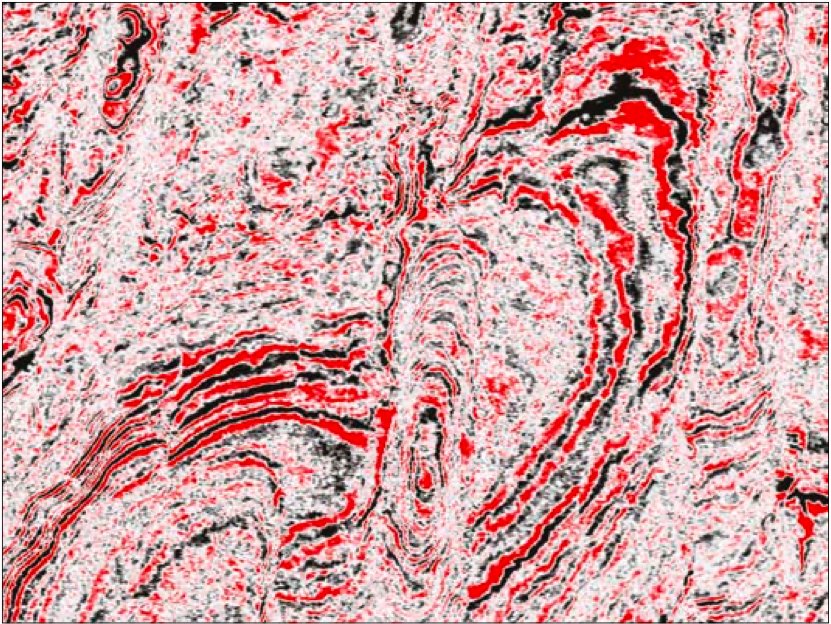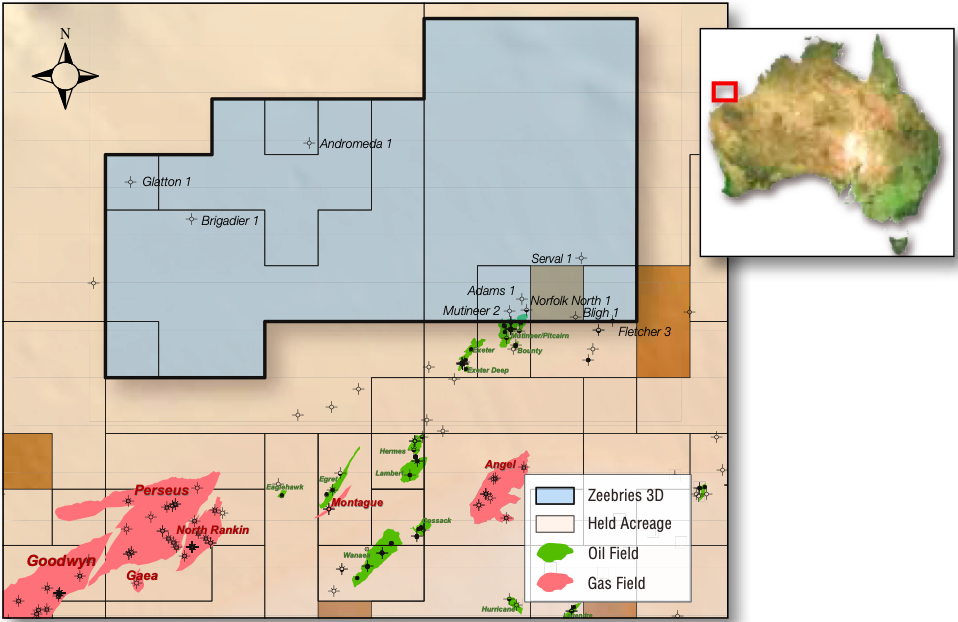Significant insights from new survey
The offshore part of the Northern Carnarvon Basin is a depocenter, which covers an area of about 535,000 km.. The basin is bounded to the north-east by the Roebuck and Canning Basins, to the south-east by the Pilbara block, to the south by the Southern Carnarvon Basin and to the north-west by the Gascoyne abyssal plain, which in turn is bounded in the north by the Java Trench/Timor Trough.
The basin is filled with thick Paleozoic, Mesozoic and Cenozoic sedimentary successions, which were deposited during multiple phases of extension and following break-up of Gondwana. A prominent north-east to south-west trend of significant structures and alignment of basins are a consequence of this rifting event, which occurred mainly during the Jurassic to Early Cretaceous. These polycyclic extensional events produced dominant structural elements, including the Beagle, Dampier, Barrow and Exmouth Sub Basins and the Exmouth Plateau and Lambert and Peedamulla Shelves.
A second, nearly north-south oriented structural trend is prominent in the Beagle Sub-Basin and adjacent areas. It can be related to the transitional character of this Sub-Basin being located between the Northern Carnarvon and the adjacent offshore Canning and Roebuck Basins.
Pre- and syn-rift stratigraphy
During the pre-rift (Silurian to Early Jurassic) extensional events caused by northward block-migration during Carboniferous times resulted in regional deposition of related sediments in the area of what is now the North Carnarvon Basin. During the Late Permian, shallow marine clastics and carbonate sediments were deposited in north-east to south-west trending depocenters (Longley et al. 2002). Regional marine transgressional events during the Triassic resulted in the deposition of shales, siltstones and minor paralic sandstones and shelfal limestones, grading into the fluvio-deltaic sandstones of the Mungaroo Formation. Fluvial and shoreline sandstones of the Mungaroo Formation are the reservoirs of some giant gas accumulations on the Rankin Platform, and the Mungaroo Formation is also a gas-prone source rock in the Dampier Sub-Basin. The shelfal sediments of the Brigadier Formation were deposited from the Late Triassic to Early Jurassic; they are also a significant gas source in the area.
The structural configuration devel-oped in the Northern Carnarvon Basin during the Early Jurassic is still apparent today. Major bounding faults separate individual sub-basins, while a combination of pre-existing Paleozoic north-south structures combined with oblique extensional directions resulted in the en echelon trend of the sub-basins seen today. The syn-rift period covered the Middle Jurassic to Early Cretaceous. The clay and siltstones of the Athol Formation were deposited in a restricted marine environment, while the overlying sandstones of the Legendre Formation are interpreted as deltaic sediments. Distal deltaic sediments are likely to provide the source of some important hydrocarbon accumulations in the area.
Continental break-up and related seafloor spreading occurred in the Oxfordian, with the break-up unconformity as one of the main events in the North West Shelf. Continuous break-up, related faulting and rapid tectonic subsidence resulted in thick marine successions, which filled the ensuing sub-basins during the Late Jurassic. High-quality, oil-prone, Oxfordian source rocks are the result of a maximum flooding phase, while at the sub-basin margins, shoreline and fluvial sandstones and related fans with potential reservoir quality have been deposited.
Upper Jurassic sandstones are the result of the erosion of Triassic rocks from uplifted blocks. They are significant as reservoir units, including shallow marine to turbiditic sandstones. These rocks are the main reservoirs in the Dampier Sub-Basin, and the Late Jurassic Jansz Sandstone is the main reservoir of the giant Io/Jansz gas field in the Exmouth Plateau.
The Barrow Delta, and deposition of the resulting Barrow Group sediments, occurred mainly during the late syn-rift phase. The delta prograded northwards over the Exmouth Sub-Basin and Exmouth Plateau and deposited a sediment thickness of about 2,500m. Two phases of delta progradation have been interpreted, with a diachronous boundary in between. The second delta lobe and related sediments were deposited in the Barrow and Dampier Sub-Basins; Barrow Group sediments show good reservoir qualities.
Post-rift stratigraphy
Post-rift subsidence (Early to Late Cretaceous) resulted in an overall transgression and consequently a deposition of a fining-upward marine sequence during Early Cretaceous times. Widespread deposition of shales, siltstones and radiolarites happened during that event. The Muderong Shale is a regional seal although it locally also contains reservoir quality sandstones. Uplift events during the Late Cretaceous caused erosion of earlier deposited rocks in the area.

During the post-rift phase (Late Cretaceous to present) widespread shelfal carbonate sediments were deposited on a passive continental margin, and uplift events resulted in a phase of inversion in areas like the Exmouth Plateau. Pre-existing rift-related structures have been reactivated with transpressional character.
The collisions between the Australia India and Eurasia plates affected north-west Australia and the Northern Carnarvon Basin (Longley et al. 2002), resulting in tilting, inversion and fault-reactivation in the area. Many structural traps within Cretaceous and Cenozoic units were created during that time.
Northern carnarvon basin petroleum systems
As has been described, the generation, migration and entrapment of hydro carbons in the Northern Carnarvon have been controlled by Jurassic to Early Cretaceous syn- and post-rift structures, syn- and post-rift deposition and Neogene reactivation. The basin contains thick successions of late Paleozoic to Cenozoic sediments with thicknesses of over 10 km. The most dominant successions are Triassic to Lower Cretaceous sedimentary units.
Gas-prone source rocks in the Barrow and Dampier Sub Basins are in general located in the Triassic fluvio-deltaic units of the Mungaroo and Brigadier Formations and the Jurassic marine to deltaic Athol and Legendre Formations. Geochemical studies undertaken in the Rankin Platform area indicate that gas accumulations there were sourced by Triassic source rocks, and accumulations in the adjacent Barrow and Dampier Sub-Basins have Jurassic source rocks.
Reservoir rocks in the Northern Carnarvon Basin are dominated by fluvio-deltaic and marginal marine clastics of the Triassic Mungaroo and the Jurassic Legendre Formations in the Beagle and Dampier Sub-Basins, and by the Lower Cretaceous Barrow Group sediments in the Barrow and Exmouth Sub-Basins and Exmouth Plateau.
Most of the discoveries in the Northern Carnarvon Basin are sealed by the lower Cretaceous Muderong Shale, an effective regional seal in the Northern Carnarvon Basin. Additional significant intraformational seal units occur in the Cretaceous Barrow Group sediments and Forestier Claystones, the Jurassic Athol and Legendre Formations and the Triassic Mungaroo Formation.
The main structural trap styles in the area are horsts, tilted fault blocks, drapes and fault-over anticlines. Stratigraphic traps include basin-floor turbidites, pinch-outs and onlaps.
Significant insights
Located along the same structural trend as producing fields, the Zeebries 3D survey adds significant insight into a highly prospective part of the Northern Carnarvon Basin. Complementary inversion by Fugro will aid in fast-tracking the interpretation process of potential reservoir intervals present in the area.
Several wells located within the survey area penetrated potential reservoir, seal and source units. Preliminary seismic interpretations confirm their distribution away from the well location within the survey area, while there is ample evidence of both stratigraphic and structural traps.
Reference:
Longley, I.M., Buessenschuett, C., Clydsdale, L., Cubitt, C.J., Davis, R.C., Johnson, M.K., Marshall, N.M., Murray, A.P., Somerville, R., Spry, T.B., and Thompson, N.B., 2002. The North West Shelf of Australia – A Woodside perspective. In: Keep, M. and Moss, S.J. (eds), The Sedimentary Basins of Western Australia 3: Proceedings of the Petroleum Exploration Society of Australia Symposium, Perth, pp. 27–88.





